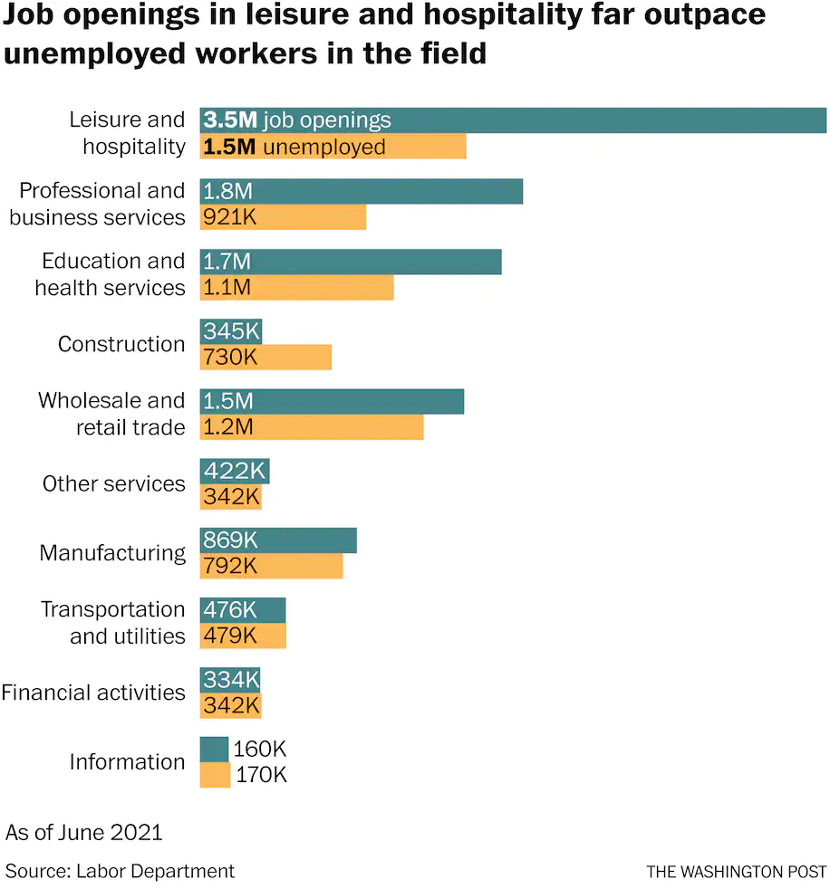Published on
New Workforce Data Points Toward Big Opportunities for Colleges and Universities

An enormous opportunity is opening up for colleges and universities in three areas, given the way in which our job market is being re-shaped in response to COVID-19. There are far more job openings than people who are unemployed and looking for work. The bulk of this mismatch is occurring in three sectors:
- Leisure and hospitality
- Professional and business services
- Education and healthcare
In the following chart (Long at al, 2021) we can see the details of this mis-match.

In each of these areas, colleges and universities have large and well-organized degree programs at both the associate and bachelor’s levels which serve the needs of rising workers in the sector. Many colleges and universities have certificate programs and contract training programs aimed at the aspiring or newly hired within these three fields.
Historically, a rising job market with a greater need for workers means that employers will be providing training to entice and keep workers. The market for contract training is already growing and will get much larger. More employers will provide tuition support to retain and help workers advance.
These are structural changes arising from a number of issues, such as a wave of retirements, reductions of new entrants due to immigration restrictions, and the challenges that parents face with children at home. These are shortages that will not go away quickly. To address these shortages, employers will need solid programs of training and development as well as improvements in salary, benefits, and job quality to entice people into the workforce. They will also need the judicious use of technology to enhance productivity.
What does this mean for colleges and universities?
A look at the three sectors reveals some opportunities.
Leisure and Hospitality consists of the following sectors:
- Accommodation, Food Services, and Drinking Places
- Performing Arts, Spectator Sports, Museums, Historical Sites, Amusement, Gambling, and Recreation Industries
This sector has many challenges: Low wages, inconsistent schedules, lack of opportunity for advancement, as well as an abundance of seasonal and part-time work. Changing restaurant work toward a more professional model is a primary task of restaurant employers. Some caution is in order. The enrollment in hospitality degree programs is not currently robust. The opportunities for universities and colleges are primarily in restaurants and hospitality:
- Contract training for new and rising workers in customer service, sanitation, and more
While degree programs may take a while to gain traction, hospitality management training and education at both the associate and bachelor level programs may take off with certificate and non-credit programs playing a leading role.
Professional and Business Services has these sectors:
- Legal, Accounting, Architectural, Engineering, Specialized Design, Computer Systems Design, Consulting Services, Scientific Research and Development Services, Advertising, Other
- Management of Companies and Enterprises
- Support Services
- Waste Collection, Waste Treatment and Disposal, and Remediation
Opportunities are primarily, but not exclusively, in management:
- Contract training for new managers, supervisors, and new support service workers
- Education for rising managers and supervisors and support service workers in associate, bachelor’s, and master’s level programs
- Education and contract training for new and rising workers in accounting services
Education and Healthcare consists of these sectors:
- Elementary and Secondary Schools, Junior Colleges, Colleges and Universities, Business Schools, Computer and Management Training, Technical and Trade Schools, and Educational Support Services
- Ambulatory Health Care Services, Hospitals, Nursing and Residential Care Facilities, and Social Assistance
Opportunities are in both education and healthcare:
- Teacher pathways enabling the movement of bachelor’s degree holders to certified teaching positions as well as degree completion for teacher certification
- Contract training with school districts to support continuing education for classroom teachers
- Contract training across healthcare to support retention and new worker induction
- Expanded pathways for achievement of RN licensure (LPN to RN, etc.)
- RN to BSN pathways
- Allied health completion pathways at associate and bachelor’s levels
More Labor Market Information
Program development in any of these sectors must be rooted in more local information. Partnerships with local employers and associations via advisory boards and other collaboration methods are vital. The program development ideal is rooted in effective local labor market information, coupled with a close relationship with local employers in the sector.
The effective use of local labor market information from firms like EMSI/Burning Glass is a vital tool. This firm “aggregates Census, BLS, O*Net, and other sources for demographic and labor market data such as Job Posting Analytics, Staffing Patterns by Industry, Job Growth, etc.” EMSI “Uses job postings for data on occupations, industries, educational programs, and demographics.” (CAEL, 2020). Root program development in local labor market information and couple that with close relationships with employers in the target area.
Conclusions
This has been a tough period for colleges and universities with declining enrollment due to our continuing demographic challenges. This hard trend has been compounded by the challenges of COVID-19. The new workforce emerging from COVID-19 points the way toward new opportunities for colleges and universities that want to address workforce challenges in cooperation with their local and national employers. Both contract training and degree completion will grow in the coming years for the colleges and universities that pay attention and are adaptable.
References
Council for Adult and Experiential Learning (CAEL), 2020. CAEL Mini Toolkit: Improve Programs and Stakeholder Engagement with Labor Market Data.
Long, H., Fowers, A., Van Dam, A. 9/4/21. Why America has 8.4 million unemployed when there are 10 million job openings. Washington Post. Retrieved from https://www.washingtonpost.com/business/2021/09/04/ten-million-job-openings-labor-shortage/
Author Perspective: Educator



